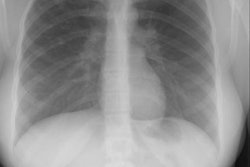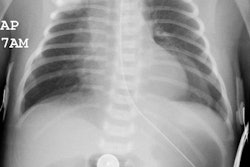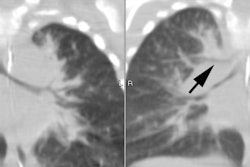Diffuse Pulmonary Lymphangiomatosis
- Clinical:
Diffuse pulmonary lymphangiomatosis (DPL) is a rare disorder
characterized by the proliferation of lymphatic vessels [1]. It
differs from pulmonary lymphangiectasis in that the lymphatics are
not only dilated, but also increased in number and extensively
interconnected [2]. The disease usually occurs in children and
young adults with an equal sex prevalence [1]. The onset of the
disease is usually insidious and the symptoms are nonspecific
including dyspnea, cough, chest pain, milky sputum, shortness of
breath, and wheezing [1]. It tends to be more aggressive in
patients who present at a younger age, usually with progressive
dyspnea leading to death from respiratory failure [2].
- X-ray:
Radiographic findings include diffuse mediastinal soft-tissue
thickening without vessel malformation, diffuse bilateral
thickening of the interlobular septa particularly in the upper
lobes due to proliferation and dilatation of lymphatic vessels,
and pleural thickening [1]. Patchy areas of ground-glass
attenuation can reflect edema, hemorrhage, or the accumulation of
hemosiderin-laden macrophages [2]. Chylous pleural and pericardial
effusions are common [1].
REFERENCES:
(1) AJR 2017; Sun X, et al. Diffuse pulmonary lymphangiomatosis:
MDCT findings after direct lymphangiography. 208: 300-305
(2) AJR 2009; Raman SP, et al. Imaging of thoracic lymphatic
diseases. 193: 1504-1513



